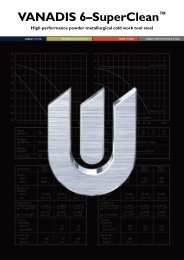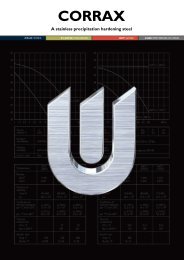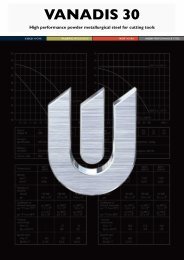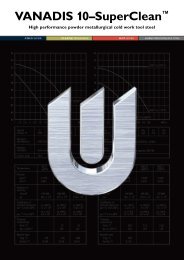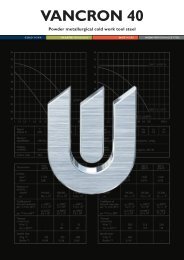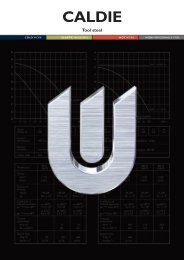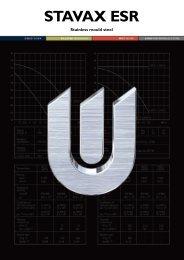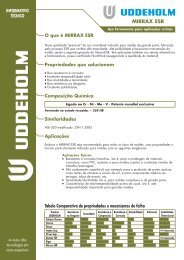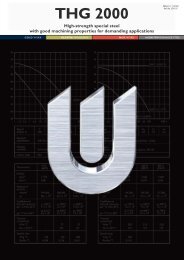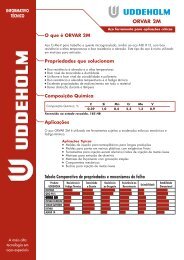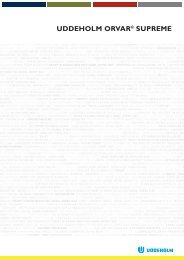CALMAX - Uddeholm
CALMAX - Uddeholm
CALMAX - Uddeholm
Create successful ePaper yourself
Turn your PDF publications into a flip-book with our unique Google optimized e-Paper software.
<strong>CALMAX</strong><br />
Plastic mould and cold work steel
<strong>CALMAX</strong><br />
General<br />
<strong>CALMAX</strong> is a chromium-molybdenum-vanadium<br />
alloyed steel characterized by:<br />
• High toughness<br />
• Good wear resistance<br />
• Good through hardening properties<br />
• Good dimensional stability in hardening<br />
• Good polishability<br />
• Good weldability<br />
• Good flame- and induction hardenability.<br />
Typical C Si Mn Cr Mo V<br />
analysis % 0,6 0,35 0,8 4,5 0,5 0,2<br />
Delivery<br />
condition Soft annealed to approx. 200 HB<br />
Colour code White/violet<br />
Applications<br />
<strong>CALMAX</strong> is a steel suitable for both cold work<br />
and plastic applications. For further information see<br />
page 6 and 7.<br />
Properties<br />
PHYSICAL DATA<br />
Temperature 20°C 200°C 400°C<br />
(68°F) (400°F) (750°F)<br />
Density<br />
kg/m 3 7 770 7 720 7 650<br />
lbs/in 3 0,281 0,279 0,276<br />
Modulus of<br />
elasticity<br />
N/mm 2 194 000 188 000 178 000<br />
psi 28,1 x 10 6 27,3 x 10 6 25,8 x 10 6<br />
Coefficient of<br />
thermal expansion to 100°C to 200°C to 400°C<br />
per °C from 20°C 11,7 x 10 -6 12,0 x 10 -6 13,0 x 10 -6<br />
to 212°F to 400°F to 750°C<br />
per °F from 68°F 6,5 x 10 -6 6,7 x 10 -6 7,3 x 10 -6<br />
Thermal<br />
conductivity<br />
W/m °C – 27 32<br />
Btu in (ft 2 h°F) – 187 221<br />
Specific heat<br />
J/kg°C 455 525 608<br />
Btu/lbs°F 0,109 0,126 0,145<br />
COMPRESSIVE STRENGTH<br />
Approximate values at room temperature.<br />
Hardness Rcm Rc0,2<br />
HRC N/mm 2 N/mm 2<br />
56 2300 1900<br />
58 2500 2000<br />
60 2700 2100<br />
IMPACT STRENGTH<br />
Approximate values at room temperature for<br />
different tempering temperatures. Hardened at<br />
960°C (1760°F). Quenched in air. Tempered twice.<br />
Typical blanking die where <strong>CALMAX</strong> could be used because<br />
of the high demands on toughness.<br />
Charpy V<br />
Impact energy, KV, (J)<br />
60<br />
50<br />
Fracture toughness<br />
KIC,(MPa√m)<br />
60<br />
50<br />
40<br />
30<br />
K IC<br />
40<br />
30<br />
20<br />
10<br />
KV<br />
20<br />
10<br />
0<br />
0<br />
200 250 300 350 400 450 500 550 600°C<br />
390 480 570 660 750 842 930 1020 1110°F<br />
Tempering temperature<br />
Mould for the production of electrical components. <strong>CALMAX</strong><br />
would be a good choice here because of the high demands<br />
on wear resistance.<br />
Cover photos:<br />
Cold work and plastic products where <strong>CALMAX</strong><br />
would be a good choice for the die/mould.<br />
2
<strong>CALMAX</strong><br />
Heat treatment<br />
SOFT ANNEALING<br />
Protect the steel and heat through to 860°C<br />
(1580°F), holding time 2h. Cool in furnace 20°C/h to<br />
770°C (35°F/h to 1420°F), then 10°C/h to 650°C<br />
(18°F/h to 1200°F) and subsequently freely in air.<br />
STRESS RELIEVING<br />
After rough machining the tool should be heated<br />
through to 650°C (1200°F), holding time 2h.<br />
Cool slowly to 500°C (930°F), then freely in air.<br />
HARDENING<br />
Preheating: 600–750°C (1110–1380°F).<br />
Austenitizing temperature: 950–970°C (1740–<br />
1780°F), normally 960°C (1760°F).<br />
Hardness<br />
Temperature Holding* time before tempering<br />
°C °F minutes (HRC)<br />
950 1740 30 62<br />
960 1760 30 63<br />
970 1780 30 64<br />
* Holding time = time at austenitizing temperature after<br />
the tool is fully heated through.<br />
Protect the part against decarburization and<br />
oxidation during hardening.<br />
QUENCHING MEDIA<br />
• Forced air/gas<br />
• Vacuum furnace with sufficient overpressure<br />
• Martempering bath or fluidized bed at<br />
200–550°C (320–1020°F) followed by forced<br />
air cooling<br />
• Oil.<br />
Note 1: Quenching in oil gives an increased risk for<br />
dimensional changes and cracks.<br />
Note 2: Temper the tool as soon as its temperature<br />
reaches 50–70°C (120–160°F).<br />
Hardness and retained austenite as a function of<br />
austenitizing temperature<br />
Hardness HRC<br />
65<br />
64<br />
63<br />
62<br />
61<br />
60<br />
59<br />
58<br />
Retained austenite %<br />
57<br />
900 925 950 975 1000 °C<br />
1650 1695 1740 1785 1830 °F<br />
Austenitizing temperature<br />
20<br />
15<br />
10<br />
5<br />
123Risk for grain growth causing reduced toughness.<br />
CCT-graph<br />
Austenitizing temperature 960°C. Holding time 30 minutes.<br />
°F<br />
2000<br />
1800<br />
°C<br />
1100<br />
1000<br />
Austenitizing temperature 960°C<br />
Holding time 30 minutes<br />
1600<br />
900<br />
A c3<br />
1400<br />
1200<br />
1000<br />
800<br />
700<br />
600<br />
500<br />
Carbides<br />
Pearlite<br />
A c 1<br />
Cooling Hard-<br />
Curve ness T 800–500<br />
No. HV10 sec.<br />
800<br />
600<br />
400<br />
200<br />
400<br />
300<br />
200<br />
100<br />
Martensite<br />
Bainite<br />
1 2 3 4 5 6 7<br />
1 820 1<br />
2 762 107<br />
3 743 423<br />
4 734 1071<br />
5 657 1596<br />
6 455 3228<br />
7 413 4292<br />
1 10 100 1 000 10 000 100 000 Seconds<br />
1 10 100 1 000 Minutes<br />
1 10 100 Hours<br />
3
<strong>CALMAX</strong><br />
TEMPERING<br />
Choose the tempering temperature according to the<br />
hardness required by reference to the tempering<br />
graph. Temper twice with intermediate cooling to<br />
room temperature. Lowest tempering temperature<br />
180°C (360°F). Holding time at temperature<br />
minimum 2h.<br />
Tempering graph<br />
Hardness HRC Retained austenite %<br />
65<br />
Austenitizing temperature<br />
60<br />
960°C (1760°F)<br />
55<br />
50<br />
45<br />
40<br />
35<br />
30<br />
25<br />
Retained austenite<br />
15<br />
10<br />
5<br />
100 200 300 400 500 600°C<br />
210 390 570 750 930 1110°F<br />
Tempering temperature (2h + 2h)<br />
DIMENSIONAL CHANGES<br />
The dimensional changes during hardening and<br />
tempering vary depending on temperature, type of<br />
equipment and cooling media used during heat<br />
treatment.<br />
The size and geometric shape of the tool are also of<br />
essential importance. Thus the tool should always<br />
be manufactured with enough working allowance<br />
to compensate for distortion. Use 0,20% as a<br />
guideline for <strong>CALMAX</strong>.<br />
An example of dimensional changes for a plate<br />
100 x 100 x 10 mm, hardened and tempered<br />
under ideal conditions, is shown in the figure<br />
below.<br />
SURFACE TREATMENT<br />
Some tools are given a surface treatment in order to<br />
reduce friction and increase tool wear resistance.<br />
The most commonly used treatments are nitriding<br />
and surface coating with wear resistant layers of<br />
titanium carbide and titanium nitride (CVD, PVD).<br />
Two commonly used nitriding processes are ion<br />
nitriding and gas nitriding. Ion nitriding is normally<br />
performed at a lower temperature than gas nitriding<br />
and is, therefore, the preferred method for <strong>CALMAX</strong><br />
when a substrate hardness of ≥54 HRC is required.<br />
Temp. Substrate Case<br />
Nitriding °C Time Case depth hardness hardness<br />
process (°F) (h) mm HRC HV<br />
Ion 465* 18 200 54 1075<br />
(870*)<br />
Gas 510* 12 200 52 1075<br />
(950*)<br />
* The nitriding temperature used should be 15–25°C (59–77°F)<br />
lower than the previously used tempering temperature.<br />
A thick case depth considerably reduces the toughness<br />
of the tool. The case depth, which can be<br />
controlled by the nitriding time, should be selected<br />
to suit the application in question.<br />
<strong>CALMAX</strong> can also be CVD coated but the deposition<br />
temperature should not exceed 960°C (1760°F). The<br />
tool should be re-hardened after being coated.<br />
PVD coatings can be deposited at temperatures<br />
between 200°C (390°F) and 500°C (930°F). If<br />
200°C (390°F) is used, the <strong>CALMAX</strong> substrate<br />
hardness will be higher than that obtained at a<br />
deposition temperature of 500°C (930°F). However,<br />
the adhesion of the coating on the steel is better if<br />
a deposition temperature of 500°C (930°F) is used.<br />
The PVD deposition temperature should be approx.<br />
20°C (68°F) lower than the previously used tempering<br />
temperature.<br />
Hardening: 960°C (1760°F)/30 min./air.<br />
%<br />
0,10<br />
0,08<br />
–– Width<br />
Length<br />
0,06<br />
..... Thickness<br />
0,04<br />
0,02<br />
0<br />
–0,02<br />
–0,04<br />
100 200 300 400 500 °C<br />
210 390 570 750 930 °F<br />
Tempering temperature (2h + 2h)<br />
4
<strong>CALMAX</strong><br />
Machining<br />
recommendations<br />
The cutting data below are to be considered as<br />
guiding values which must be adapted to existing<br />
local condition.<br />
Condition: Soft annealed to approx. 200 HB<br />
TURNING<br />
Rough Fine Fine turning<br />
Cutting data turning turning High speed<br />
parameters carbide carbide steel<br />
Cutting speed<br />
(v C )<br />
m/min 150–200 200–250 20–25<br />
f.p.m 492–656 656–820 66–82<br />
Feed (f)<br />
mm/r 0,2–0,4 0,05–0,2 0,05–0,3<br />
i.p.r 0,008–0,016 0,002–0,008 0,002–0,01<br />
Depth of cut (a P )<br />
mm 2–4 0,5–2 0,5–3<br />
inch 0,08–0,16 0,02–0,08 0,02–0,12<br />
Carbide<br />
designation ISO P20–P30 P10 –<br />
US C6–C5 C7 _<br />
Coated Coated carbide<br />
carbide or cermet<br />
DRILLING<br />
High speed steel twist drill<br />
Drill diameter Cutting speed (v c ) Feed (f)<br />
mm inch mm inch mm/r i.p.r.<br />
–5 –3/16 13–15* 43–49* 0,05–0,10 0,002–0,004<br />
5–10 3/16–3/8 13–15* 43–49* 0,10–0,20 0,004–0,008<br />
10–15 3/8–5/8 13–15* 43–49* 0,20–0,25 0,008–0,010<br />
15–20 5/8–3/4 13–15* 43–49* 0,25–0,30 0,010–0,012<br />
* For coated HSS drill v c =23–25 m/min. (75–82 f.p.m.).<br />
Carbide drill<br />
Type of drill<br />
Cutting data Solid Indexable Brazed<br />
parameters carbide insert carbide 1)<br />
Cutting speed<br />
(v C<br />
) m/min 120–150 210–230 70–100<br />
f.p.m 394–492 689–755 230–328<br />
Feed (f)<br />
mm/r 0,10–0,35 2) 0,03–0,12 2) 0,15–0,40 2)<br />
i.p.r 0,004–0,014 2) 0,001–0,005 2) 0,006–0,016 2)<br />
1)<br />
Drills with internal cooling channels and a brazed tip.<br />
2)<br />
Depending on drill diameter.<br />
MILLING<br />
Face and side milling<br />
Cutting data Rough milling Fine milling<br />
parameters carbide carbide<br />
Cutting speed (v C<br />
)<br />
m/min 160–240 240–280<br />
f.p.m 525–787 722–919<br />
Feed (f Z<br />
)<br />
mm/tooth 0,2–0,4 0,1–0,2<br />
in/tooth 0,008–0,016 0,004–0,008<br />
Depth of cut (a P<br />
)<br />
mm 2–5 –2<br />
inch 0,08–0,20 0,08<br />
Carbide<br />
designation ISO P20–P40 P10–P20<br />
End milling<br />
US C6–C5 C6–C7<br />
Coated carbide<br />
Coated carbide<br />
or cermet<br />
Type of end mill<br />
Carbide<br />
Cutting data Solid indexable High speed<br />
parameters carbide insert steel<br />
Cutting<br />
speed (v C<br />
)<br />
m/min 120–150 150–200 40–45 1)<br />
f.p.m 394–492 492–656 131–148 1)<br />
Feed (f Z<br />
)<br />
mm/tooth 0,006–0,20 2) 0,06–0,20 2) 0,01–0,35 2)<br />
in/tooth 0,0002–0,008 2) 0,002–0,008 2) 0,0004–0,014 2)<br />
Carbide<br />
designation<br />
ISO – P15–P40 –<br />
US – C6–C5 –<br />
1)<br />
For coated HSS end mill v C<br />
=55–60 m/min. (180–197 f.p.m.).<br />
2)<br />
Depending on radial depth of cut and cutter diameter.<br />
GRINDING<br />
A general grinding wheel recommendation is given<br />
below. More information can be found in the<br />
<strong>Uddeholm</strong> brochure “Grinding of Tool Steel”.<br />
Wheel grinding<br />
Soft annealed Hardened<br />
Type of grinding condition condition<br />
Face grinding straight wheel A 46 HV A 46 HV<br />
Face grinding segments A 24 GV A 36 GV<br />
Cylindrical grinding A 46 LV A 60 KV<br />
Internal grinding A 46 JV A 60 JV<br />
Profile grinding A 100 LV A 120 JV<br />
5
<strong>CALMAX</strong><br />
Welding<br />
Good results when welding <strong>CALMAX</strong> can be<br />
achieved if proper precautions are taken.<br />
1. Always keep the arc length as short as possible.<br />
The electrode should be angled at 90° to the<br />
joint sides to minimize under cut. In addition,<br />
the electrode should be held at an angle of 75–<br />
80° to the direction of forward travel.<br />
2. For large repairs, weld the initial layers with a<br />
soft weld metal. Make the two first layers with<br />
the same electrode diameter and current.<br />
3. Large repair welds should be made at elevated<br />
temperature.<br />
4. The joints should be prepared properly.<br />
TIG Welding recommendations<br />
Hardness Hardness after Preheat<br />
Consumables as welded rehardening temper<br />
UTPA 73G2 53–56 HRC 51 HRC<br />
UTPA 67S 55–58 HRC 52 HRC<br />
CastoTig 5* 60–64 HRC 200–250°C<br />
<strong>CALMAX</strong>/CARMO (390–480°F)<br />
TIG WELD 58–61 HRC 58–61 HRC<br />
*CastoTig 5 should not be used for more than 4 layers because of the<br />
increased risk of cracking.<br />
MMA (SMAW) Welding recommendations<br />
Hardness Hardness after Preheat<br />
Consumables as welded rehardening temper<br />
ESAB OK 84.52 53–54 HRC 49 HRC<br />
UTP 67S 55–58 HRC 52 HRC<br />
CITODUR 600B 57–60 HRC 53–54 HRC<br />
Fontargen E 711 57–60 HRC 53–54 HRC<br />
<strong>CALMAX</strong>/CARMO<br />
WELD 58–61 HRC 58–61 HRC<br />
HEAT TREATMENT AFTER WELDING<br />
Hardened condition<br />
Temper at 10–20°C (50–70°F) below the original<br />
tempering temperature.<br />
Soft annealed condition<br />
Heat through to 860°C (1580°F) in protected<br />
atmosphere. Cool in furnace at 10°C/h to 650°C<br />
(18°F/h to 1200°F), then freely in air.<br />
Further information on welding of tool steel is given<br />
in the <strong>Uddeholm</strong> brochure “Welding of Tool Steel”.<br />
EDM<br />
200–250°C<br />
(390–480°F)<br />
If spark erosion is performed in the hardened and<br />
tempered condition, the tool should be given an<br />
additional temper at about 25°C (35°F) lower than<br />
previous tempering temperature<br />
Cold work applications<br />
TYPICAL APPLICATION AREAS<br />
• General blanking and forming<br />
• Heavy duty blanking and forming<br />
• Deep drawing<br />
• Coining<br />
• Cold extrusion dies with complicated geometry<br />
• Rolls<br />
• Shear blades<br />
• Prototype tooling.<br />
TRADITIONAL PRESSWORK STEELS<br />
The majority of presswork tools used today are<br />
manufactured using traditional tool steels such as<br />
O1, A2, D2, D3 or D6.<br />
These steels offer an apparent adequate wear<br />
resistance and their hardness range is suitable for<br />
most applications. However, the poor toughness,<br />
flame- and induction hardenability and weldability<br />
of these grades often results in low productivity and<br />
high maintenance costs due to unexpected tool<br />
failure. For this reason, the new general presswork<br />
tool steel <strong>CALMAX</strong> has been developed. The aim of<br />
<strong>CALMAX</strong> is to secure an optimal tooling economy,<br />
i.e. the lowest tooling costs per part produced.<br />
TODAYS DEMANDS<br />
The pressworking industry has gone through some<br />
considerable changes in the last decades. Stainless<br />
steel and surface coated strip have been commercialized<br />
and high speed presses have been developed.<br />
To these technological advances just in time<br />
(JIT) manufacture and the moves toward increased<br />
productivity and tool life guarantees must be added.<br />
The traditional presswork tool steels are still<br />
routinely specified and selected but often result in<br />
poor tool performance and productivity.<br />
The well balanced properties profile of <strong>CALMAX</strong> is<br />
much better matched to modern work materials and<br />
manufacturing methods. <strong>CALMAX</strong> offers the high<br />
degree of safety which is essential for optimal<br />
tooling performance and maximum productivity.<br />
RESISTANCE TO FAILURE MECHANISMS<br />
Abra- Adhe-<br />
<strong>Uddeholm</strong> sive sive Gross Deforgrade<br />
wear wear Chipping Cracking mation<br />
<strong>CALMAX</strong><br />
ARNE<br />
SVERKER 21<br />
SVERKER 3<br />
RIGOR<br />
SLEIPNER<br />
6
<strong>CALMAX</strong><br />
Plastic moulding<br />
applications<br />
TYPICAL APPLICATION AREAS<br />
• Long run moulds<br />
• Moulds for reinforced plastics<br />
• Moulds for compression moulding.<br />
The excellent combination of toughness and wear<br />
resistance makes <strong>CALMAX</strong> suitable for different<br />
moulding applications.<br />
Moulds made in <strong>CALMAX</strong> will have good resistance<br />
to abrasion and give a safe and long production life.<br />
WELDING<br />
For best results after polishing and etching use<br />
consumables with the same composition as the<br />
mould steel, i.e. use <strong>CALMAX</strong>/CARMO consumables.<br />
PROPERTY COMPARISON CHART<br />
<strong>Uddeholm</strong> Wear<br />
steel grade resistance Toughness Polishability<br />
<strong>CALMAX</strong><br />
GRANE<br />
ORVAR SUPREME<br />
RIGOR<br />
Further information<br />
Please contact your local office for further information<br />
on the selection, heat treatment, application<br />
and availability of <strong>Uddeholm</strong> tool steels, including<br />
the publications “Steels for Moulds” and “Steels for<br />
Presswork Tooling”.<br />
PHOTO-ETCHING AND POLISHING<br />
<strong>CALMAX</strong> has a very homogeneous structure. This<br />
coupled with its low content of non metallic<br />
inclusions (due to vacuum degassing during<br />
manufacturing) ensures accurate and consistent<br />
pattern reproduction after the photo-etching<br />
process and very good surface finish after polishing.<br />
Etching should be done in a media used for steel<br />
with high chrom-content.<br />
Further information is given in the <strong>Uddeholm</strong><br />
brochure “Photo-etching of Tool Steel” and “Polishing<br />
Mould Steel”.<br />
This information is based on our present state of knowledge and is<br />
intended to provide general notes on our products and their uses.<br />
It should not therefore be construed as a warranty of specific properties<br />
of the products described or a warranty for fitness for a particular<br />
purpose.<br />
7



